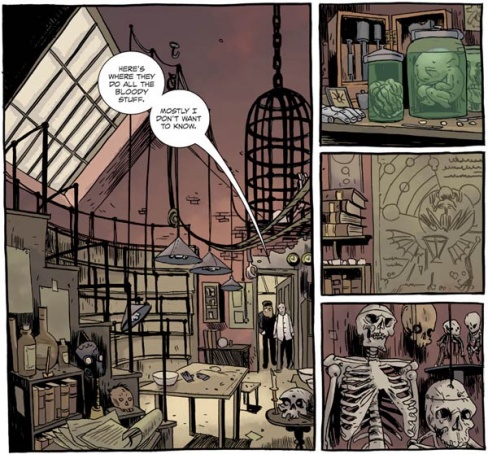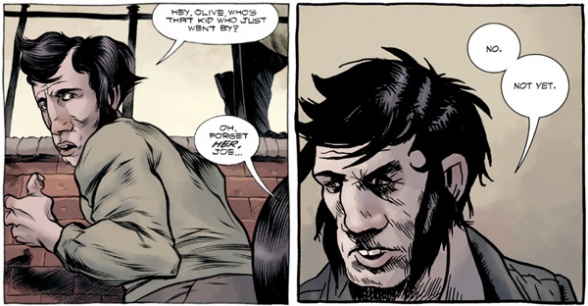
“Jenny Finn” #4, the final issue of the miniseries, undergoes a transformation as Farel Dalrymple steps in as artist on the series. Meanwhile, the plot struggles to come together as its tone and subject matter don’t quite mesh.
Written by Mike Mignola and Troy NixeyCover by Mike Mignola
Illustrated by Farel Dalrymple
Colored by Dave Stewart
Lettered by Ed DukeshireJenny has been captured and the terrible plague is coming to an end, but when Joe has the chance to escape London, a ghost from his past forces him to stay and finish what he started.
Mike: Here we are at the last issue, and it’s been quite a ride. I think I’m realizing that I may have been too wowed by the art in this series back when BOOM! was publishing it. Revisiting it, I can see some of the cracks in the veneer.
But before we get into any of that, can we just gush about Farel Dalrymple for a few? I first saw his stuff way back in the Meathaus anthologies, and it’s been really interesting watching his cartooning advance. This issue of “Jenny Finn,” in hindsight, almost feels like a way station on the road to the artist he’d become. It’s work that’s beyond his early anthology stuff, but not quite where he’d be for “Omega the Unknown,” and just hinting at what’s to come with something like “The Wrenchies.” There’s something about Dalrymple’s style and approach that feels so surreal that I think he makes this seemingly hasty wrap up land. Dalrymple is no stranger to weird storytelling, just check out his Study Group strip “It Will All Hurt” (link: http://studygroupcomics.com/main/it-will-all-hurt-by-farel-dalrymple/) and you’ll get the gist of what I’m talking about.
I feel like I keep hinting at the story stuff I want to pick at, but I’m really curious about what you thought of Dalrymple and the shift between Nixey and him. Have you read a lot of his comics previously?
Mark: No, I hadn’t. My exposure is limited to “The Wrenchies.” I’m just guessing here, but it feels like Mike Mignola was involved with the page layouts. I remember Mignola saying he used to send artists layouts, and while working with Duncan Fegredo on “Darkness Calls” he had to learn to let go. This was certainly before then. In this issue there were several moments that jumped out as being very Mignola-ish in their pacing, but I didn’t remember anything jumping out to that degree in Troy Nixey’s issues. Perhaps because Nixey was cowriting Mignola was less hands on with the art.

This strikes me as a very Mignola-esque layout.
It’s interesting you describe this as being a way station, but we also have to consider Dalrymple is coming onto a miniseries for the final issue, picking up where Nixey left off, so I wonder how much of what we’re seeing is Dalrymple trying to be harmonious with the previous issues.
Mike: That’s an interesting thought, though I feel like there are enough of Dalrymple’s idiosyncrasies on display to dissuade me on it. I mean, he’s definitely following Nixey/Mignola’s character sheets, but in a way that’s his own. I’ll subscribe to your thoughts on page layouts. Dalrymple’s a strong storyteller, but for someone at that point in his career to take cues from Mike Mignola? That’s hardly a stretch.
I found it interesting how Stewart seemed to subtly shift his approach to colors on this issue, skewing gently in the direction of something that resembles Dalrymple’s own color choices, which tend towards softer hues and washy tones.

Mark: Honestly, I found the art transition pretty seamless. Obviously Nixey and Dalrymple are different artists, but the tone of the book was maintained from #3 to #4. The biggest difference I found is that Nixey loves the weirdness of things and tries to push that aspect of it. With Dalrymple the book takes on a more ominous quality. Given the turn of events in “Jenny Finn,” this totally works.
My big problems with this one are all story related, particularly in the way its characters are presented. As you know, #2 bothered me a great deal, and while this issue doesn’t go as far as that again, there are some persistent problems. It really gets my hackles up when Hornbee’s ghost shows up and claims he’s an innocent victim, doomed to wander the earth forever because of Joe’s mistakes, and it seems the narrative agrees with this hot take. And I still think it’s very problematic for a story that condemns so many women to be told primarily through male characters, and where the titular woman is basically a vessel for other characters’ ideas and never emerges as a character in her own right. Women are used time and time again, to the point that it seems like a central theme of the book, but the theme never goes anywhere or develops. It almost seems incidental.
Continued belowMike: The idea of women that are either used or relegated to being undeveloped characters is something that bothered me as well. From the story opening in a brothel where the women were used only as a means of progressing the narrative, to your very excellent point on Jenn Finn herself, this series has got some real flaws. I struggle with holding a nearly twenty-year-old work to the standards of today, but seeing as how Dark Horse has elected to re-publish the series, I think that opens it up to a different type of scrutiny than if it was an out of print work.
Beyond issues with characterization, I feel like there are some structural flaws to this issue, and the series as a whole. Part of me wants to point to “Jenny Finn” as a work of surrealism, where each bizarre occurrence comes hotly on the heels of the last. But that’s the apologist in me.
If I judge the series based solely on what is contained between its covers, and not an assumed set of intentions, I cannot justify the narrative stumbling blocks. Everything just seems to happen for the sake of it happening, purely because it needs to. For example, how could lumbering, seemingly simple Joe suddenly become a confident, swashbuckling secret agent? Do the clothes really make the man?
I don’t think they do.
Instead, Joe became whatever he needed to be in that moment, just as he had in every moment preceding this one. I really want it to work for the aforementioned reasons of surrealism and avant garde storytelling. Instead I’m left with a cast of characters that are flat who are tasked with navigating through a gauntlet of disjointed happenings.
And then there’s the whole Jack the Ripper thing, which just sort of fizzled and went away.
Mark: Honestly, I feel like the Jack the Ripper aspect of this story is almost entirely extraneous. It doesn’t contribute much to the story other than to act as a red herring for the real trouble and as a general sort of “flavor” for the setting, and as such it goes largely unexamined. Not that you can’t do that, of course, many stories have, but I don’t like those stories.
The ending plays very much like King Kong, complete with the monster’s fall down into the streets. There’s tragedy there, but it’s a little frustrating that none of the characters, especially Joe, seem to grasp the true scope of it. As far as they see it, Jenny Finn was an instrument of doom and she had to die, but there’s no acknowledgement of humanity’s role in making her a monster in the first place or the arrogance of men in trying to control her that led to her unnecessary suffering and inevitable death. Like Carl Denham at the end of King Kong saying, “It was beauty killed the beast,” they spectacularly missed the point.
Mike: Well put.
Mark: I guess the reason the ending doesn’t work for me is that it pulls from familiar sources to tell this tale, and yet it doesn’t do much new with these ideas. In the telling the events and characters remain largely unexamined and feel half-formed. Joe does the things he does because those’re the kind of things his character type does in these sorts of stories.
Mike: And that’s really disappointing, right? Because a lot of Mignola’s genius in storytelling is his reinterpretation of themes and ideas, which then creates fresh narratives. That’s not at all what we got out of “Jenny Finn,” though. What say we close up shop on this one?
I read this series many moons ago, and apparently nineteen-year-old me was far less scrutinizing than thirty-four year old me. Dalrymple’s art went a long way for me, but it wasn’t enough to overlook the issue’s narrative flaws. I’ll give it a 5.
Mark: I agree. I don’t fault the art at all (I very much enjoyed that aspect), but the further I’ve got into “Jenny Finn,” the less engaged I’ve felt. My overall impression of the miniseries is that of potential that wasn’t realized.
Final verdict: 5 – While the art feels new, the story feels dated and underdeveloped.







